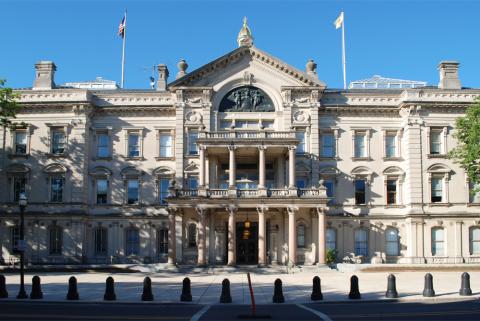New Jersey's capital city of Trenton is rich in arts, history and science - all within walking distance of the New Jersey State House. Plan a day to discover and explore this historic and fascinating district in the heart of Trenton. The Capitol Complex offers programs and exhibits for families, children, students, adults and seniors.
New Jersey's State Museum highlights American fine art of the 19th through 21st centuries, historic objects that tell the story of New Jerseyans at home, work and play. Also on display are Native American artifacts that relate the prehistory of the state's earliest inhabitants and a broad natural history collection featuring specimens that provide information on the earth sciences. The State Museum also includes a Planetarium, the largest such facility in the state. The Planetarium features a state-of-the-art precision projection of more than 6,000 stars in the full-dome video. It can comfortably seat 140 visitors in specially designed reclining seats that help to transport audiences to any astronomical destination. State Museum visitors will explore a diverse range of topics through exhibitions, special events and educational programs featuring the four distinct collection areas - Archaeology/ Ethnology, Cultural History, Fine Art and Natural History.
A short walk away is the historic New Jersey State House, the second oldest continuously operating capitol building in the nation. See the magnificently restored legislative chambers, artwork and furnishings. In addition to guided tours, the State House offers interactive exhibits that quiz visitors about the state's history, people and places.
Across the street from the State House is Trenton's World War II Memorial that pays tribute to the greatest military victory for the United States. It was an effort in which every citizen contributed and had a stake in the outcome, both on the front lines and at home. The WWII Memorial unfolds around the overall theme of Victory, with three core ideas, which are analogous to the WWII Generation: Service, Duty and Sacrifice. The central sculptural element, named Lady Victory symbolically encompasses the greatness of this effort and the grace and courage of the WWII generation.
Around the corner from the State House is the Old Barracks Museum that housed Hessian troops during the critical first battle of Trenton during the American Revolution. The Colony of New Jersey built the Barracks in 1758 during the French and Indian War. During the Revolutionary War, the Old Barracks was witness to the Battle of Trenton in 1776, a critical turning point in the American Revolution. Today, the Old Barracks serves as an educational center for Colonial and American history and stands as the last remaining structure of its kind in the nation. Old Barracks staff provides daily tours and interpretations of American Colonial life.
Across the street from the Old Barracks is the War Memorial, housing Patriots Theatre that hosts headline entertainers and shows throughout the year. The Theatre seats 1,807 in a setting of Italian Renaissance Revival splendor. Patriots Theater has been the stage for world-class artists and entertainers.
A few blocks away is the 1719 William Trent House Museum, the oldest building in New Jersey's capital city and was once home to the man for whom the city is named. Trenton has been rewarding visitors with rich cultural and heritage experiences for 300 years. History comes alive at the Trent House. Built between 1716 and 1719, this National Historic Landmark was the country home of William Trent, a Philadelphia merchant and his family. Visitors to the house take a step back in time and receive amazing insight into the many layers of Colonial life during the early 18th century and its later role in the Battle of Trenton.

